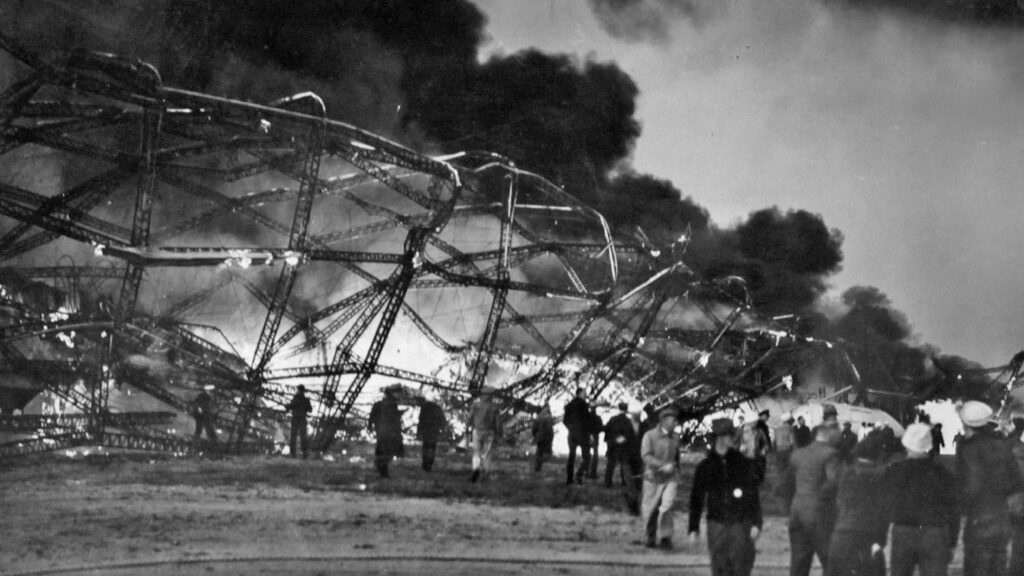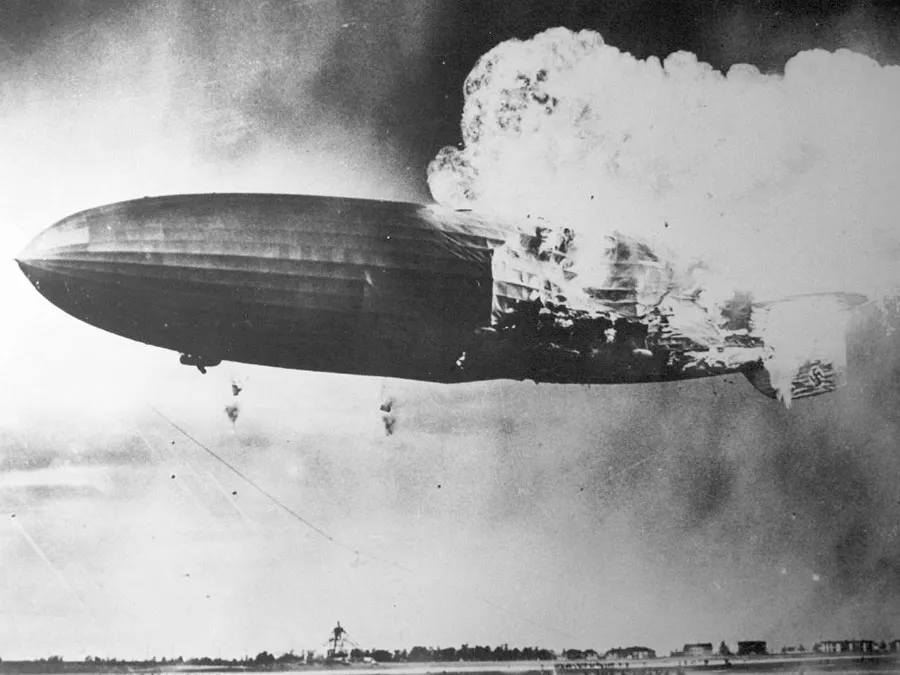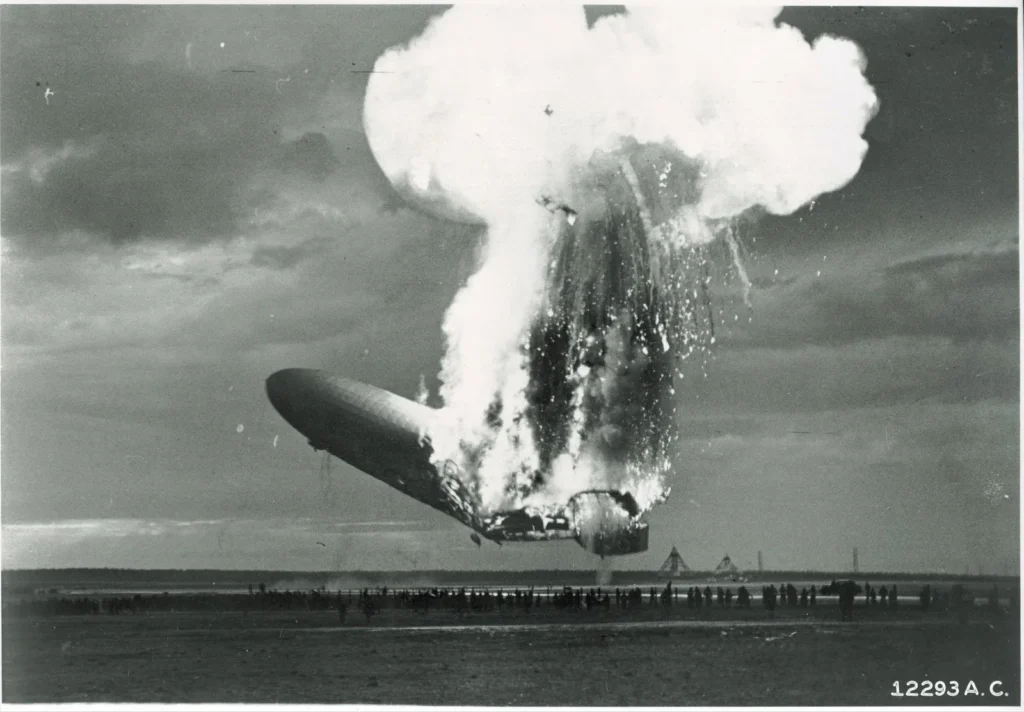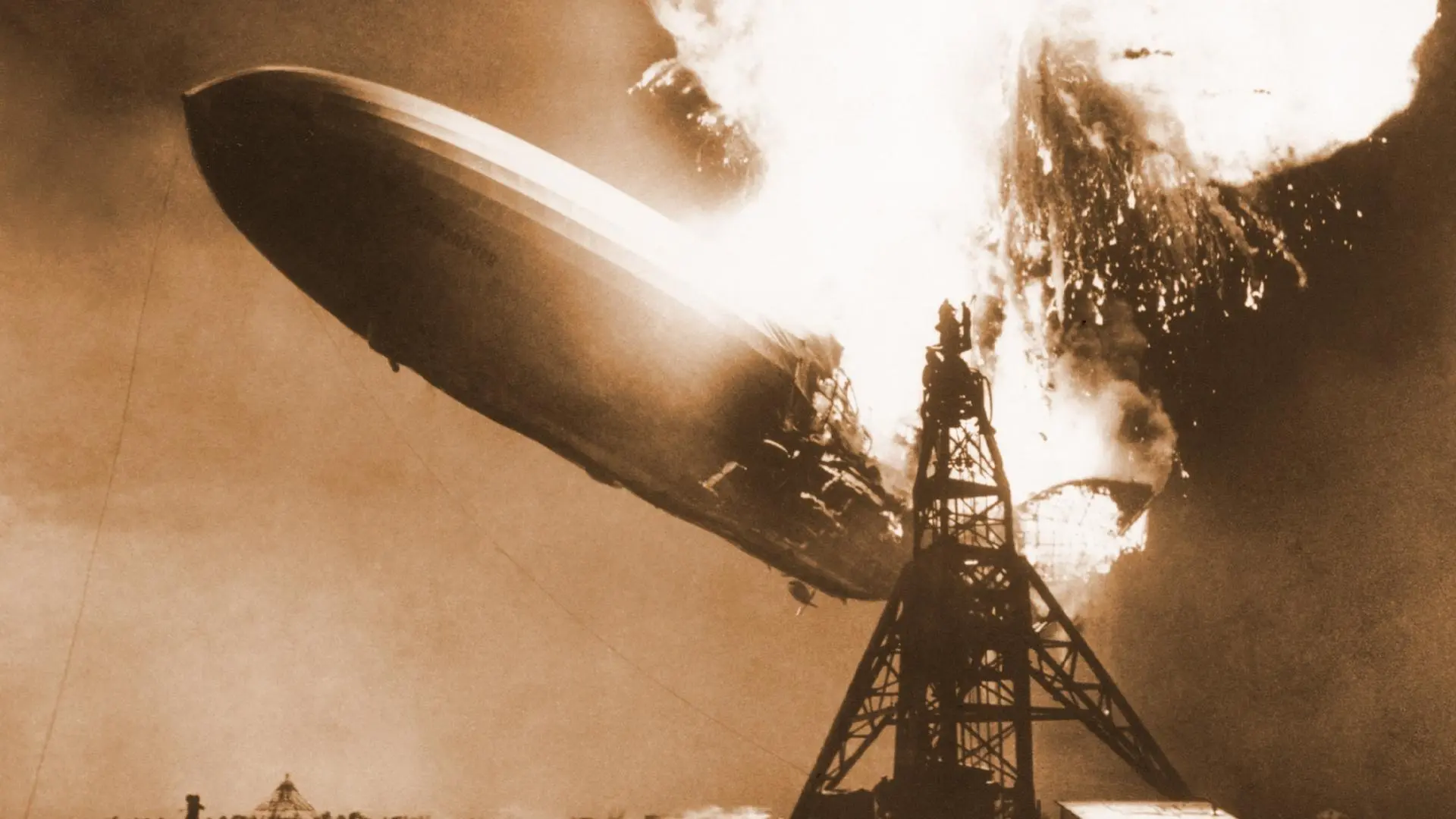The Hindenburg Disaster: A Brief History
The Hindenburg was a German commercial airship that was one of the largest aircraft ever built. It was 245 meters in length and had a diameter of 41 meters. The airship made its first commercial flight on March 4, 1936, and quickly became popular for its luxurious amenities and comfortable accommodations.
However, on May 6, 1937, the Hindenburg met with a tragic end when it burst into flames while attempting to dock at the Naval Air Station in Lakehurst, New Jersey. The Disaster resulted in the death of 36 people – including crew members and passengers – out of a total of 97 individuals who were aboard the ship.
The Mysterious Explosion

The cause of the explosion has been shrouded in mystery ever since it occurred more than eighty years ago. Eyewitnesses described seeing flames engulfing the Hindenburg from one end to another before it crashed to the ground. The incident was a shock not just to those who witnessed it live but also to those around the world who learned about it through news reports.
Some theories have been proposed over time regarding what caused this tragedy, while others have remained silent regarding any possible cause or reason behind this catastrophic event. Nevertheless, many still wonder what caused such an enormous catastrophe and if anything could have been done to prevent it.
Was the explosion due to mechanical failure or sabotage? Was there something more sinister happening behind the scenes?
There’s no hard evidence supporting any particular theory — just speculation based on rumours, eyewitness accounts, and historical context. In this article, we explore different theories surrounding this mysterious event and some lesser-known facts that might help shed some light on what really happened that fateful day back in May of 1937.
Theories about the Explosion
Sabotage: possible motives and evidence
One of the most popular theories surrounding the Hindenburg disaster was that it was caused by sabotage. Many believe that someone intentionally caused the explosion to disrupt air travel or even harm specific passengers on board.
One suspected motive is that anti-Nazi groups wanted to send a message to Hitler’s government, which had been using airships for propaganda. Several pieces of evidence support this theory, including reports of a man sneaking on board with a suspicious package before takeoff.
Witnesses also reported seeing flames before the explosion, indicating that some fire-starting device may have been used. Additionally, some believe a disgruntled crew member may have been involved in the sabotage.
Technical Malfunction: potential causes and supporting evidence
Another theory about the Hindenburg disaster is that a technical malfunction caused it. Airships were still a relatively new technology at the time, and many components were involved in their operation. Some experts believe a spark ignited hydrogen gas inside one of the gas cells, causing an explosion.
Supporting evidence for this theory includes reports from witnesses who saw sparks coming from various parts of the ship before it exploded. Additionally, there were documented issues with gas leaks and electrical systems on previous flights, indicating potential mechanical problems.
Natural Disaster: weather conditions and their impact on the Hindenburg
Some experts postulate that natural factors played a role in causing the Hindenburg disaster. Specifically, they point to weather conditions during takeoff – specifically high levels of static electricity – as contributing factors.
Reports indicate an electrical storm brewing in New Jersey on May 6, 1937, when Hindenburg took off from Frankfurt towards Lakehurst Naval Air Station – its final destination. Others mention the possibility of lightning, which could have caused a spark to ignite the hydrogen gas inside the ship.
While this theory is less popular than sabotage or technical Malfunction, it’s still a possibility that can’t be completely ruled out. And even if weather factors contributed to the Disaster, there may still be further questions about why other airships had flown successfully in similar weather conditions.
Eyewitness accounts of the explosion

Eyewitnesses to the Hindenburg disaster were forever imprinted by the horror they witnessed. Most notable among them was Herb Morrison, a Chicago radio journalist assigned to cover the airship landing for his station. His famous recording of the event captured the emotional and harrowing experience that left many in tears as they heard it broadcast worldwide.
Morrison’s account was corroborated by other witnesses who recounted how flames suddenly erupted from one side of the Hindenburg, spreading quickly and devouring everything in their path. Other eyewitness accounts described passengers and crew members leaping from windows or being thrown out as they attempted to escape certain death.
Some onlookers watched in horror as individuals burned alive before their eyes, while others were crushed under debris or burned beyond recognition. The scenes that unfolded that day left many deeply scarred and traumatized.
Analysis of wreckage and debris
To determine what caused the Hindenburg disaster, experts analyzed wreckage and debris from what remained of the once-mighty airship. Investigators studied everything from burn patterns to charred metal fragments, measuring temperatures and carefully documenting each piece of evidence at the scene. They also analyzed flight records, maintenance logs, passenger manifests and other relevant documents to determine what happened.
Their findings indicated that much of what happened that day could be attributed to static electricity igniting leaking hydrogen gas within a gas cell on one side of the ship. The fire rapidly spread along cables within its envelope before being fueled by various combustible materials onboard, such as varnish coatings on furniture.
Conclusions from official investigations
The official investigation into what caused the Hindenburg disaster took several months to complete but ultimately concluded that it was likely sparked by static electricity igniting hydrogen gas within one end of its envelope. But while this explanation provided some answers, it also raised new questions about how such a catastrophic event could have occurred. Critics of the official investigation pointed to evidence that suggested sabotage or technical Malfunction might have played a role.
Despite the official findings, many remain convinced there was more to what happened than meets the eye. As with many high-profile tragedies, conspiracy theories continue to abound and fuel public interest in the Hindenburg mystery more than 80 years after its infamous end.
Controversies Surrounding the Mystery
Conspiracy Theories About Sabotage
One of the most popular conspiracy theories about the Hindenburg disaster is that it was an act of sabotage. Some speculate that a bomb was placed on the board by a foreign government or political group. Others suggest that it could have been an inside job carried out by a crew member with ulterior motives.
However, despite extensive investigations and analysis of debris and eyewitness accounts, no concrete evidence has emerged to support these conspiracy theories. While it’s certainly possible that sabotage played a role in the Disaster, most experts agree that it’s unlikely, given the lack of solid evidence.
Criticisms of Official Investigations
The official investigations into the cause of the Hindenburg disaster have faced some criticism over the years. Some argue that investigators were too quick to dismiss certain possibilities (such as sabotage) without fully considering all available evidence.
Others suggest that political pressures or other external factors may have influenced investigators. However, these criticisms are largely speculative, and no concrete evidence supports them.
Alternate Explanations Proposed by Experts
While no single explanation for the Hindenburg disaster has been universally accepted, there are several theories proposed by experts in various fields. One possibility is that a static discharge ignited hydrogen gas leaking from one or more of the airship’s fuel cells.
Another theory suggests that a spark from faulty wiring could have ignited flammable materials on board. Still, others point to poor design or maintenance practices as contributing factors.
Ultimately, while each theory has some merit, there is no clear consensus on what caused the Hindenburg disaster. Regardless of which explanation is ultimately proven true (if any), this enduring mystery continues to captivate and intrigue people worldwide today.
The Legacy of the Hindenburg Disaster
Impact on Air Travel Industry
The Hindenburg disaster marked a turning point in the history of air travel. Before this event, airships were considered luxurious and safe transportation.
However, after the tragedy, public confidence in airships plummeted, and they were largely replaced by aeroplanes. The Disaster also sparked a wave of safety regulations that greatly improved aeroplane safety.
Cultural Significance in Popular Media
The Hindenburg disaster had a profound impact on popular culture. It remains an object of fascination for many people today. Numerous films and documentaries have been made about the event, including “Hindenburg: The Last Flight” and “Zeppelin.” This tragedy has influenced music; Led Zeppelin’s famous song “Kashmir” includes the lyrics “To talk of many things: Of shoes—and ships—and sealing-wax-Of cabbages—and kings—And why the sea is boiling hot—And whether pigs have wings.”
Lessons Learned for Future Safety Measures
One important lesson from the Hindenburg disaster was that safety should always come first. Since then, countless measures have been implemented to ensure that similar tragedies do not occur again.
Modern aircraft have numerous safety features, such as fire suppression systems, backup power supplies, and redundant control systems. Additionally, strict regulations have been put in place to ensure that all aircraft adhere to high safety standards.
While the Hindenburg disaster was a tragic event that resulted in significant loss of life, it also brought about important changes to the world of aviation. The legacy of this event lives on through its impact on popular culture and its influence on modern safety regulations within aviation industries across the globe.
The Unanswered Questions and Speculations

What caused the explosion?
The question of what caused the Hindenburg disaster has puzzled historians, scientists, and aviation experts for over eight decades. Some theories suggest that it was due to sabotage by anti-Nazi activists or American spies.
Other theories propose that a technical malfunction in the hydrogen gas cells caused a spark to ignite, leading to the explosion. However, evidence supporting either theory is inconclusive.
While some claim that sabotage is a plausible explanation, there are no conclusive pieces of evidence that could support this theory. Also, if it was indeed sabotage, how did the perpetrators manage to carry out such an attack undetected?
The technological limitations of surveillance systems at that time made it difficult to answer these questions definitively. On the other hand, technical Malfunction is a more probable cause for the Disaster.
Hydrogen gas is highly combustible and prone to ignition, even with a tiny spark or static electricity buildup. This was one reason why helium eventually replaced hydrogen as a safer alternative for airship travel.
Could it have been prevented?
Whether the Hindenburg disaster could have been prevented has been debated since its occurrence in 1937. Certain safety measures were in place then, including regular inspections and maintenance checks on airships before they took off; however, these measures were not enough to prevent such an enormous tragedy.
One safety measure which would have made a significant difference was using helium instead of hydrogen as a fuel for airships. Helium is non-flammable, which would have eliminated any chance of explosions during flight.
However, Germany had limited access to helium as most natural sources were found in America. Overall though, given what was known about hydrogen’s flammability at the time and still today, it’s reasonable to say if someone had suggested an alternative fuel source, it would’ve been taken seriously.
What if it had landed safely?
The Hindenburg disaster was a catastrophic event that claimed 36 lives and injured many others. However, what if the airship had landed safely without any explosion? Would airship travel continue to be a viable form of transportation?
Likely, there would still have been concerns about the safety of airships, given that they relied on flammable hydrogen gas as their primary fuel source. Even with regular maintenance checks and safety measures, there would always be a risk of Disaster.
Additionally, the growing popularity of aeroplanes during that period meant less demand for airships as a mode of transportation. The Hindenburg disaster was ultimately the final nail in the coffin for large-scale commercial airship travel and marked the end of an era.
While we may never know exactly what caused the Hindenburg tragedy or how it could have been prevented, it remains an event shrouded in mystery and speculation that continues to captivate our imaginations decades later.
Conclusion
Summary of Main Points Discussed in Paper
Throughout this article, we have explored the myriad factors that contributed to the tragic explosion of the Hindenburg airship on May 6, 1937. From potential sabotage to technical malfunctions and natural disasters, there are many theories about what caused this Disaster.
We have also looked at the various investigations conducted over time and how they have led to different conclusions. We considered this Disaster’s legacy and how it has affected air travel and popular culture.
Reflections on Enduring Interest in Hindenburg Mystery
Despite all we know about this event, it remains an enduring mystery that still captures people’s imaginations today. Part of what makes this Disaster so fascinating is that there are still unanswered questions surrounding it.
What if it had landed safely? Could it have been prevented?
These questions keep us coming back for more. But beyond simply satisfying our curiosity, the enduring interest in the Hindenburg mystery reminds us of our mortality and vulnerability.
It underscores how much we rely on technology to keep us safe and how quickly things can go wrong when they fail. But despite these risks, humans continue to push forward with scientific progress to improve our lives.
And perhaps therein lies a glimmer of hope – that even when things go wrong, we never stop striving for something better. While we may never know what caused the Hindenburg disaster or why its story continues to captivate so many people today, one thing is clear: our fascination with this tragedy speaks volumes about our humanity – its fragility and its resilience in seeking answers amid uncertainty.
